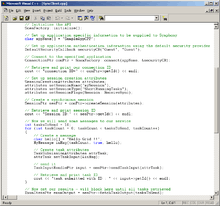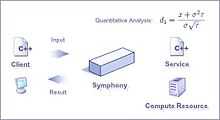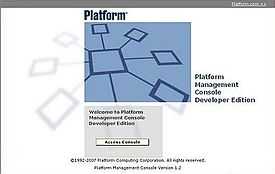Symphony Developer Edition
|
Symphony DE's Management Console launched from Internet Explorer | |
| Developer(s) | Platform Computing |
|---|---|
| Stable release | 4.1 / December 2008 |
| Operating system | Linux, Solaris, Microsoft Windows |
| Available in | C++, Java, .NET |
| Type | High-performance computing |
| License | Freeware |
| Website | www.platform.com |
Symphony Developer Edition (Symphony DE) is a free High-performance computing (HPC) and Grid computing SDK and middleware developed by Platform Computing. It is a light-weight version of the cluster-based Symphony commercial software. Symphony DE is aimed at providing a dedicated development environment for building compute and data-intensive applications.[1] It has been described as "the first and only solution tailored for developing and testing Grid-ready service-oriented architecture applications".[2]
Symphony DE was designed to provide an easy to manage system for developers to code, test, and tune their HPC applications. From building to testing, work can be performed on one development host. Users do not have to worry about deploying and managing a full-scale cluster environment.
Latest Release
The latest iteration of the software, Symphony DE 5.1, was released in April 2011. New features include simplified application integration, improved resource harvesting, GPU support and enhanced performance and scalability.[3]
Availability
The software package is downloadable at no cost from Platform Computing's website. The DE cluster can be deployed without any time or node-count limitations.[4] By reducing the barriers to adopting Symphony, Platform intends to promote the benefits of HPC not only to the financial services industry, but to any industries or institutions interested in using distributed computing services.
Available Packages:
| Linux | Solaris | Windows |
|---|---|---|
|
|
|
Features
Difference between Symphony and Symphony DE
- Symphony DE does not include the Enterprise Grid Orchestrator (EGO) resource management component used by Symphony. It does support basic resource distribution and host management through its own SOA Middleware. This allows developers to simulate a distributed environment on their own machines for testing clients and services without requiring a full Symphony cluster.
- The web-based GUI management console is scaled down to exclude grid specific features such as reporting and advanced resource management. The DE management console provides developers with an interface to manage applications, monitor workload, and administer the test environment in a similar fashion to the full-scale grid version.[5]
- Symphony DE includes additional developer oriented components such as the Symphony SDK, sample applications, and step-by-step developer tutorials.
Symphony SDK

Developers construct their own client (send requests, collects results) and service (accepts requests, performs computation, returns responses) using Symphony APIs in the language of their choice (C++, Java, C#, COM API).[6] As the Symphony product evolved, its API interface has become easier to learn and use. A typical client and service can be implemented with a small number of API calls.
The Symphony DE package provides a set of examples illustrating the functionality of both client and service side APIs in common usage scenarios. These examples however, do not include any demonstration of real-life financial applications.
Existing executables such as binaries and scripts can also be integrated and run as a Symphony tasks without reimplementing the application source code.[7] The client can use Symphony API to launch and control the execution. The limitation is that data cannot be passed between client and service.
Applications

Finance
Symphony targets the Financial Services industry which demands high-performance and reliability in compute and data-intensive environments. Symphony DE can be used to develop and test financial applications that run complex mathematical algorithms such as Monte Carlo. The Symphony Service can be integrated with quantitative finance libraries such as QuantLib to model price evaluations for academics and practitioners alike.[8][9] Platform has completed technical integrations with application partners such as Murex, Summit Systems, Calypso, Catalyst, Tillinghast, GGY, Imagine and Codefarm.[10]
Production applications of Symphony in Financial Services industry:
- Fixed-income derivatives and analytics. Monte Carlo, Black–Scholes-type applications[11]
- Credit risk management [12][13]
- Risk, pricing and value at risk (VaR) calculations[14]
- Equity derivatives trading[15]
- Rainbow option, Stochastic volatility models[16]
- Sophis, Summit, Microsoft Excel or Fast Crisp[17]
Vendor Support
Symphony DE users can post product related questions and feedbacks on the my.platform.com forum. Registration is required in order to post.
References
- ↑ Shread, Paul (2007-12-11). "Platform Speeds Up Symphony". Grid Computing Planet. Retrieved 2008-02-29.
- ↑ "Platform Targets Banks with Symphony 3". Grid Today. 2006-06-26. Retrieved 2008-02-29.
- ↑ "Platform Symphony 5.1 - An Overview of New Features for Application Developers and Administrators". Platform official site. 2011.
- ↑ "Platform Symphony 4.0 is now Generally Available!". Platform official site. 2007. Retrieved 2008-03-02.
- ↑ "Symphony Developer Whitepaper" (PDF). Platform official site. 2007. Retrieved 2008-03-02.
- ↑ "Platform Symphony Foundations" (PDF). Platform official site. 2007. Retrieved 2008-03-03.
- ↑ "Application Development Guide" (PDF). Platform official site. 2007. Retrieved 2008-03-03.
- ↑ "QuantLib 0.8.1 released". IT Financial News. 2007-07-29. Retrieved 2008-03-09.
- ↑ "Four years of open source financial models". Wilmott Magazines. 2004. Retrieved 2008-03-09.
- ↑ "Platform Continues Grid Momentum in Financial Services". Grid Today. 2005-06-27. Retrieved 2008-03-31.
- ↑ Daly, Rob (2008-01-29). "Lehman Works to Share Grids". Dealing with Technology. Retrieved 2008-03-31.
- ↑ "Société Générale Grid-Enables Credit Risk System". Grid Today. 2007-10-01. Archived from the original on 2008-02-25. Retrieved 2008-03-31.
- ↑ "Platform Grid-enables SocGen, LBBW and Capital One". Finextra. 2003-09-09. Retrieved 2008-03-31.
- ↑ "Platform Computing signs BNP Paribas Arbitrage to Grid package". Finextra. 2005-10-17. Retrieved 2008-03-31.
- ↑ "GERMAN BANK SELECTS PLATFORM TO ACCEL EQUITY DERIVATIVES TRADING". Grid Today. 2004-11-29. Retrieved 2008-03-31.
- ↑ "Sal. Oppenheim claims first-mover advantage with a grid solution from IBM and Platform". IBM. 2007-01-04. Archived from the original on 2008-04-30. Retrieved 2008-03-31.
- ↑ Mohamed, Arif (2006-09-26). "How grid power pays off for HSBC". Computer Weekly. Retrieved 2008-04-27.
